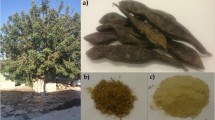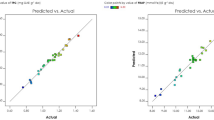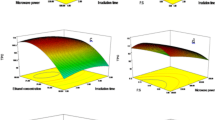Abstract
Valorization of biomass based on feedstock has become an urgent necessity in terms of sustainability. Materials produced from fossil fuels will eventually run out. Therefore, it is inevitable to evaluate particularly food and agricultural wastes that have no economic value or even threaten the environment. In this study, olive tree (Olea europeae) has been investigated with respect to its by-product such as leaf. Several conventional solvents (ethanol, methanol, acetonitrile, and acetone solutions) were used to obtain an extract rich in total phenolics (TPI), flavonoids (TFI), and antioxidant activity (AA) by means of microwave-assisted extraction (MAE). On the other hand, 3-factor and 3-level central composite design (CCD) was applied via the response surface method (RSM) to determine the optimum experimental conditions of the parameters that were effective on a small number of experiments. Generally, solvent volume was the most effective parameter for each solvent system (P < 0.05). The process parameters of the extraction system were selected as microwave power (150–250 W), time (0.5–1.5 min), and solvent volume (50–100 mL). The best findings for TPI, TFI, and AA were found 10.45-mg GAE/g DL, 9.69-mg CE/g DL, and 96.34% under the optimal conditions (230 W, 1.5 min, and 63.16 mL of 30% acetonitrile solution).





Similar content being viewed by others
References
Şahin S, Elhussein EAA (2018) Valorization of a biomass: phytochemicals in oilseed by-products. Phytochem Rev 17:657–668
Şahin S, Saeed N, Malik A et al (2012) Seasonal changes of individual phenolic compounds in leaves of twenty olive cultivars grown in Texas. J Agric Sci Technol B J Agric Sci Technol 2:242–247
İlbay Z, Haşimoğlu A, Özdemir OK, Ateş F, Şahin S (2017) Highly efficient recovery of biophenols onto graphene oxide nanosheets: valorisation of a biomass. J Mol Liq 246:208–214. https://doi.org/10.1016/J.MOLLIQ.2017.09.046
Şahin S, İlbay Z, Kırbaşlar Şİ (2015) Study on optimum extraction conditions for olive leaf extracts rich in polyphenol and flavonoid. Sep Sci Technol 50:1181–1189. https://doi.org/10.1080/01496395.2014.966203
İlbay Z, Şahin S, Büyükkabasakal K (2014) A novel approach for olive leaf extraction through ultrasound technology: response surface methodology versus artificial neural networks. Korean J Chem Eng 31:1661–1667. https://doi.org/10.1007/s11814-014-0106-3
Alu’datt MH, Alli I, Ereifej K et al (2011) Optimisation and characterisation of various extraction conditions of phenolic compounds and antioxidant activity in olive seeds. Nat Prod Res 25:876–889. https://doi.org/10.1080/14786419.2010.489048
Goldsmith CD, Vuong QV, Stathopoulos CE, Roach PD, Scarlett CJ (2018) Ultrasound increases the aqueous extraction of phenolic compounds with high antioxidant activity from olive pomace. LWT Food Sci Technol 89:284–290. https://doi.org/10.1016/j.lwt.2017.10.065
Şahin S, Ciğeroğlu Z, Özdemir OK, Bilgin M, Elhussein E, Gülmez Ö (2019) Recovery of hydroxytyrosol onto graphene oxide nanosheets: equilibrium and kinetic models. J Mol Liq 285:213–222. https://doi.org/10.1016/j.molliq.2019.04.097
Şahin S, Ciğeroğlu Z, Özdemir OK, Elhussein E, Gülmez Ö (2020) Investigation of graphene oxide as highly selective adsorbent in recovery of hydroxytyrosol from olive mill wastewater. Int J Environ Sci Technol 17:1–12. https://doi.org/10.1007/s13762-020-02813-x
Khemakhem I, Ahmad-Qasem MH, Catalán EB, Micol V, García-Pérez JV, Ayadi MA, Bouaziz M (2017) Kinetic improvement of olive leaves’ bioactive compounds extraction by using power ultrasound in a wide temperature range. Ultrason Sonochem 34:466–473. https://doi.org/10.1016/j.ultsonch.2016.06.010
Kiritsakis K, Goula AM, Konstantinos et al (2018) Valorization of olive leaves: spray drying of olive leaf extract. 9:619–633. https://doi.org/10.1007/s12649-017-0023-x
Guinda Á (2006) Use of solid residue from the olive industry. Grasas Aceites 57
Bouaziz M, Sayadi S (2005) Isolation and evaluation of antioxidants from leaves of a Tunisian cultivar olive tree. Eur J Lipid Sci Technol 107:497–504. https://doi.org/10.1002/ejlt.200501166
Tabera J, Guinda Á, Ruiz-Rodríguez A, Señoráns FJ, Ibáñez E, Albi T, Reglero G (2004) Countercurrent supercritical fluid extraction and fractionation of high-added-value compounds from a hexane extract of olive leaves. J Agric Food Chem 52:4774–4779. https://doi.org/10.1021/jf049881+
Boudhrioua N, Bahloul N, Ben Slimen I, Kechaou N (2009) Comparison on the total phenol contents and the color of fresh and infrared dried olive leaves. Ind Crop Prod 29:412–419. https://doi.org/10.1016/j.indcrop.2008.08.001
Lee O-H, Lee B-Y, Lee J, Lee HB, Son JY, Park CS, Shetty K, Kim YC (2009) Assessment of phenolics-enriched extract and fractions of olive leaves and their antioxidant activities. Bioresour Technol 100:6107–6113. https://doi.org/10.1016/j.biortech.2009.06.059
Lee O-H, Lee B-Y (2010) Antioxidant and antimicrobial activities of individual and combined phenolics in Olea europaea leaf extract
Mylonaki S, Kiassos E, Makris DP, Kefalas P (2008) Optimisation of the extraction of olive (Olea europaea) leaf phenolics using water/ethanol-based solvent systems and response surface methodology. Anal Bioanal Chem 392:977–985. https://doi.org/10.1007/s00216-008-2353-9
Banožić M, Babić J, Jokić S (2020) Recent advances in extraction of bioactive compounds from tobacco industrial waste-a review. Ind Crop Prod 144:112009
Zin MM, Anucha CB, Bánvölgyi S (2020) Recovery of phytochemicals via electromagnetic irradiation (microwave-assisted-extraction): betalain and phenolic compounds in perspective. Foods 9:918. https://doi.org/10.3390/foods9070918
Şahin S (2015) A novel technology for extraction of phenolic antioxidants from mandarin (Citrus deliciosa Tenore) leaves: solvent-free microwave extraction. Korean J Chem Eng 32:950–957. https://doi.org/10.1007/s11814-014-0293-y
Ateş F, Şahin S, İlbay Z, Kırbaşlar Şİ (2017) A green valorisation approach using microwaves and supercritical CO2 for high-added value ingredients from Mandarin (Citrus deliciosa Tenore) leaf waste. Waste Biomass Valorization:1–14. https://doi.org/10.1007/s12649-017-0074-z
Şahin S, Elhussein E, Bilgin M, Lorenzo JM, Barba FJ, Roohinejad S (2018) Effect of drying method on oleuropein, total phenolic content, flavonoid content, and antioxidant activity of olive (Olea europaea) leaf. J Food Process Preserv 42:e13604. https://doi.org/10.1111/jfpp.13604
Şahin S, Pekel AG, Toprakçı İ (2020) Sonication-assisted extraction of Hibiscus sabdariffa for the polyphenols recovery: application of a specially designed deep eutectic solvent. Biomass Convers Biorefinery:1–11. https://doi.org/10.1007/s13399-020-00837-4
Bezerra MA, Santelli RE, Oliveira EP, Villar LS, Escaleira LA (2008) Response surface methodology (RSM) as a tool for optimization in analytical chemistry. Talanta 76:965–977. https://doi.org/10.1016/J.TALANTA.2008.05.019
Moradi M, Fazlzadehdavil M, Pirsaheb M, Mansouri Y, Khosravi T, Sharafi K (2016) Response surface methodology (RSM) and its application for optimization of ammonium ions removal from aqueous solutions by pumice as a natural and low cost adsorbent. Arch Environ Prot 42:33–43. https://doi.org/10.1515/aep-2016-0018
Bhat B, Vaid S, Habib B, Bajaj BK (2020) Design of experiments for enhanced production of bioactive exopolysaccharides from indigenous probiotic lactic acid bacteria. Indian J Biochem Biophys 57:539–551
Spigno G, De Faveri DM (2009) Microwave-assisted extraction of tea phenols: a phenomenological study. J Food Eng 93:210–217. https://doi.org/10.1016/J.JFOODENG.2009.01.006
Ahmed D, Khan M, Saeed R (2015) Comparative analysis of phenolics, flavonoids, and antioxidant and antibacterial potential of methanolic, hexanic and aqueous extracts from Adiantum caudatum leaves. Antioxidants 4:394–409. https://doi.org/10.3390/antiox4020394
Funding
The authors thank the Research Fund of Istanbul University-Cerrahpaşa for financial support for this research project (Project No: FBA-2017-23905).
Author information
Authors and Affiliations
Corresponding author
Additional information
Publisher’s Note
Springer Nature remains neutral with regard to jurisdictional claims in published maps and institutional affiliations.
Supplementary Information
ESM 1
(DOCX 31 kb)
Rights and permissions
About this article
Cite this article
Kırbaşlar, Ş.İ., Şahin, S. Recovery of bioactive ingredients from biowaste of olive tree (Olea europaea) using microwave-assisted extraction: a comparative study. Biomass Conv. Bioref. 13, 2849–2861 (2023). https://doi.org/10.1007/s13399-020-01194-y
Received:
Revised:
Accepted:
Published:
Issue Date:
DOI: https://doi.org/10.1007/s13399-020-01194-y




